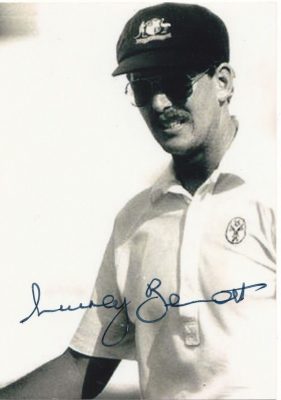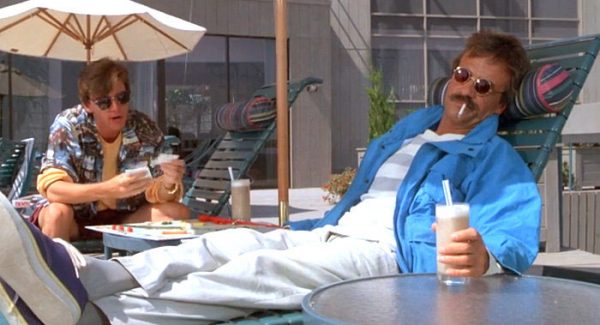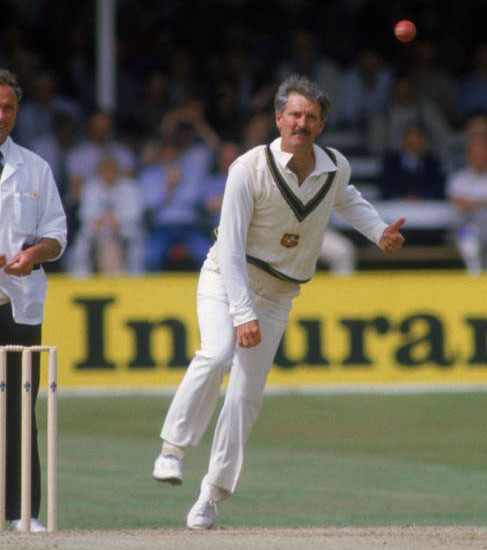In this week’s edition of In Search of West Indies Cricket, Roger Seymour continues to look at the Test matches lost by the West Indies during their streak of not losing a Test series from the summer of 1980 to February 1995.
Part II is presented as an excerpt from a script (the writer’s imagination) for a documentary on Clive Lloyd’s term as West Indies Captain. The script is written with the thought in mind that it would be read by a couple members of Lloyd’s all-conquering sides and the writer thinks that Joel Garner would be the ideal narrator for this section. ‘Big Bird’s’ knowledge of, and enthusiasm for, the game is second to none. He is a raconteur extraordinaire, who possesses an amazing recall for matches and is always willing to talk about the game.
Roger Harper’s interview took place via email and he responded on September 10, 2018.
The opening three minutes of video footage will be the team’s arrival in Australia, snippets of Lloyd’s first press conference, the team at nets, going through its paces with the adopted West Indian, Australian physiotherapist/trainer, Dennis Waite. Highlights of the second innings of the second tour match, West Indies versus South Australia where the West Indies compiled 514 for 5 in a drawn game. Greenidge (79), Haynes (94), Richards (102), Dujon (151 not out) and Lloyd (63).
Narrator: The eighth official West Indies tour party arrived in Sydney, Australia on Monday, October 15, 1984. It was in fact our fourth visit in six seasons, but the first full tour since the 5-1 thrashing served up by the tough Australians during the disastrous tour of 1975-76.
The selection panel of Chairman Clyde Walcott, Jackie Hendriks, Andy Ganteaume and the Skipper had endorsed the same 16-man squad from the just-concluded summer tour of England, with the lone newcomer being Winston Davis, who had replaced the injured Milton Small, during the English tour, courtesy of Glamorgan, his county team.
For the rest of us, it was like roll call at the start of a new school year; same faces, just another form, or in this instance, another territory. The Skipper, Vivi (Richards) the vice, Soca (Eldine Baptiste), Duj (Jeff Dujon), Larry (Gomes), G’s (Gordon Greenidge), Juice (Roger Harper), Dessi (Desmond Haynes), Mikey (Holding), Gus (Logie), Maco (Marshall), Thelston (Payne), Richie (Richardson), Cuddy (Courtney Walsh) and myself (Joel Garner). The usual suspects were back for our fourth gathering in 12 months: India, October 1983; followed immediately by the Benson and Hedges Triangular One Day Tournament in Australia in January and February; the Caribbean, March; England, May and now here we were Down Under.

Wes Hall, who had managed the team in India, was back at the helm, after quitting his job as the personnel manager at Banks Breweries in Barbados, a few days before we departed, following management’s refusal to grant him no-pay leave again. Hall, a legendary fast bowler in his day, didn’t think twice about quitting the job. Cricket is life, work can always be had.
The aggressive Australian media corps anxiously awaited Clive’s press conference before we departed for Brisbane, for our opening game versus Queensland. The Skipper was very conservative in his answers, even suggesting that the Australians were the favoured side because of the home field advantage. He avoided starting a war of words when asked about former Australian wicketkeeper Rod Marsh’s comments, “… that the Australians should fight fire with fire… and crack a few skulls.” Ever the diplomat, the Skipper noted that our team’s approach was very professional; we knew that Rodney Hogg and Carl Rackemann were very good fast bowlers and we were aware of the young Queenslander pacer Craig McDermott, who was expected to make his debut during the series.
This was Clive’s swansong, his final Test series, against our toughest opponents, coupled with the fact that we were riding an incredible eight-Test win streak, having won the last three of the home series versus the Aussies earlier in the year, then sweeping all five in England, the famous Blackwash triumph. We were now tied with Warwick Armstrong’s Australian teams of 1920/21 for one of the most hallowed records in Test cricket, most consecutive wins.
Looking back now, we can only wonder what the Australian Cricket Board was thinking when it drew up the schedule for the Test matches. The First Test was set for Perth, Western Australia. We loved the fast pitch at the WACA, (Western Australia Cricket Association), in fact it was the site of the lone win on that 75/76 tour, which I suspect was always at back of the minds of the Skipper, Vivi, G’s and Mikey, the holdovers from that series.
We beat Western Australia by nine wickets in three days, as Walsh, Holding and Davis scuttled the side for 111 in their second innings. After three matches against state sides we were acclimatized and ready for the First Test which began on Friday, November 9.
Five minutes of video of the First Test. Kerry Packer’s Channel Nine network

which owned the television rights has wonderful archival footage of the series. The camera work is superb and very entertaining commentary is provided by former Australian Test cricketers, Richie Benaud, Bill Lawry, Ian Chappell and Keith Stackpole and former England cricketers Tony Greig and Frank Tyson.
Australian Captain Kim Hughes won the toss and invited us to bat on a pitch which had been under prepared because of two days of rain. Greenidge and Haynes began steadily and soon had 50 on the board, before Terry Alderman, on his return to Test cricket after being injured by an intruding spectator two seasons before, grabbed four wickets for five runs, and we slipped from 83 without loss to 104 for 5. It was now up to Larry, Jeff and the four fast bowlers.
It was at this point, I think, that we demonstrated the kind of resolve which made us such a great team. Larry and Jeff, both batting without helmets were struck on the head. Jeff had not scored yet, and although he tried to continue, with a helmet, he had to retire with dizzy spells. Maco went out and held the fort at one end, as Larry, Mr Reliable, (laughing), dug in at the other. Jeff returned upon Maco’s dismissal and we limped to the close of play with the scoreboard reading 211 for 6.
Larry and Jeff were not separated until an hour after lunch the next day, as they took the score to 335. Jeff’s century included an array of spectacular drives. Yours truly added 50 for the ninth wicket as we further frustrated the Australians. Larry, last out for 127, after seven and three-quarter hours at the wicket, received a standing ovation from us all upon his return to the dressing room. Larry was at his best when our backs were against the wall and his valiant knock set the tone for the series.
The match could have been over on the third day, as we routed the Aussies for 76, their lowest total ever against us. Following on, they extended the game into the fourth morning, before surrendering for 228. The fast bowlers were wonderfully supported by the slip cordon of the Skipper at first, Vivi, Richardson and Gordon, as they, along with Jeff behind the stumps, took 15 catches. We won by an innings and 12 runs and laid claim to the record for the most consecutive Test wins.
A minute of video dedicated to the superb slip catches taken by the West Indies. This footage will then run into five minutes of highlights of the Second Test, focusing on Richie and Lloyd’s partnership in the West Indies first innings.
The series then shifted to the Gabba in Brisbane, Queensland, where we repeated the formula of the WACA Test. Restrict the Australians to a low first innings score, 175 in this instance, and then accumulate a total over 400, after a mid-innings slump. This time it was Richie and the Skipper notching centuries, as they added 152 in 122 minutes for the sixth wicket. It was Lloyd’s nineteenth in Tests, at the same venue where, on his first appearance Down Under, way back in December ’68, he had scored his third, a second innings ton, as Garry Sobers’ team won the opening Test. We lost two unnecessary wickets in the second innings getting 20-odd runs to go two up, in four days.
Three minutes from the Australian Captain’s post-match press conference.
At the post-match press conference Kim Hughes tendered his resignation as Australian Captain. Hughes broke down whilst reading a statement he had prepared, “The constant speculation, criticism and innuendo by former players and section of the media over the past four-five years have finally taken a toll. It is in the interest of the team…” Hughes paused, choking back emotion. “It’s in the interest of the team and Australian cricket…” unable to continue, Hughes handed the handwritten statement to the Australian Manager Bob Merriman to finish reading. The stunned Australian media could only manage one question.
In hindsight, losing five straight to us coupled with his loss of form must have taken its toll on Hughes. After his classic Boxing Day century against us in 1981, Hughes had become the focus of our attack and he had received no quarter from us.
Five minutes of highlights from the Third Test match.
The Third Test was at the Adelaide Oval, which was celebrating its centenary anniversary as a Test-match venue. Allan Border was the new Australian Captain and Roger replaced Mikey, who had a muscle strain injury. We won the toss, opted to bat and Gordon (95), missed out on his first century in Australia when Hogg took a spectacular catch on the boundary. The Skipper (78) and Jeff (77) added 150 for the sixth wicket. Mr Reliable chipped in with 60, and while no one else managed double figures, we still posted 356.
Larry got his sixth century off the Australians in his second knock, while Kepler Wessels enjoyed scores of 98 and 70, the highest in the two Australian innings. Maco, with his second five-wicket haul of the match and Harps with four, bowled the Australians out on the last day, as we won by 191 runs to take an unassailable 3-0 lead in the series, thus retaining the Frank Worrell Trophy for the fifth consecutive series.
Five minutes of highlights from the Fourth test match.
The Fourth Test in Melbourne began on December 22, and the Australian selectors, desperate to stop the losing in the now ‘Dead Rubber’ series (Australian term for the series already decided by earlier matches) made four changes. John Dyson, David Boon, Bob Holland and Terry Alderman were out, and in came Andrew Hilditch, Greg Matthews, and debutantes Murray Bennett and Craig McDermott. Meanwhile, we retained the same line-up from Adelaide.
Viv, who had gone ten consecutive Test innings without a 50, finally came good with his third double century in Tests (208) adding 149 for the seventh wicket with Maco, who got his second 50 of the series. Mr Reliable contributed 68, as for the fourth consecutive Test, we continued our trend of losing half of our wickets for less than 200 runs; this time we recovered to our highest score of the series, 479.
A critical last-wicket partnership of 43 between Bennett and Hogg, allowed Australia to avoid the follow on, after Hilditch (70) and Wessels (90) had threatened big scores. We didn’t make our second innings declaration until 15 minutes into the final morning, leaving Australia a target of 370 in 275 minutes plus 20 overs. Our conservative approach cost us precious time, and although we reduced Australia to 17 for 3 before lunch, the task was always going to be a difficult one. Opener Hilditch, on his return to Test cricket after five years, with gritty support from Border, wicketkeeper Steve Rixon and finally Bennett, occupied the crease for 339 minutes for a very determined century (113); as Australia, with eight wickets down, salvaged a hard-earned draw.
Footage of the dejected West Indies team leaving the field at the conclusion of the match.
The consecutive streak had been broken in a match we should have won. Melbourne was the last of Kim Hughes’ Test career. It was a very sad ending for a good batsman, whose last four innings brought him just two runs, including three ducks, two of them first ball.
Footage of Kim Hughes’ last four, albeit very brief, test innings.
The final Test at Sydney, New South Wales (NSW), approximately an hour and a half flying time from Melbourne, began three days later, on Sunday, yes, Sunday, December 30. It was one year and one day since the last Test of the India tour, which meant we would be playing our sixteenth Test in a year, bearing in mind that 1984 was a leap year.
Footage of the second innings of the NSW versus West Indies match.
We had lost to NSW between the First and Second Test matches in a strange encounter. Harps, five wickets, and Viv, four had bowled out NSW for 129 in their second innings, leaving us 205 to get for the victory. They dismissed us for 133, as only the Skipper with 47, provided any resistance.
They, or rather, Bob Holland and Murray Bennett, the spin duet, on a helpful wicket had been responsible for this debacle. Between the two, they had garnered 15 wickets, with Bennett, three and six, grabbing the spotlight, as he twice had Viv, then at the peak of his powers, caught and bowled.
The desperate Australian selectors had immediately selected the pair, neither of whom had ever appeared in a Test match, among the squad for the Second Test. Holland played the Second and Third Tests, taking only four wickets, two in each Test, as Bennett performed the duties of twelfth man. Bennett replaced Holland at Melbourne, as the selectors also opted for the bat of their NSW team mate, all-rounder/off spinner Greg Matthews. However, for the Sydney Test match, much to the joy of NSW supporters, the spin twins of Holland and Bennett were slotted into the final 11.
Holland and Bennett, two odd-bods, were not your prototype Test cricketers. The greying Holland nicknamed ‘Dutchy,’ heard that he had been selected for the Brisbane Test whilst listening to the radio on the drive home after the state match with the West Indies. The 46-year-olds Don Blackie and Bert Ironmonger, in 1928, were the only Australians older than the 38-year-old, right-arm, leg-spinner Holland on Test debut. In fact, Holland hadn’t appeared in a first-class game until the age of 32.
Holland delivered teasing leg-breaks and googlies, whilst cleverly controlling his flight and length. According to the Wisden, “Leg-spin was an endangered species at the time, especially in Australia, but Holland had old-fashioned virtues – seductive flight, disciplined length, a well-disguised top-spinner and a sparingly used wrong ‘un – all dispensed with a ready smile.”
Bennett, Holland’s sidekick, a left-arm, orthodox spinner was equally mysterious. Recently I was looking at an old comedy movie from the late 1980s, Weekend at Bernie’s, in which the film’s headliner, Bernie, is dead for most of it. Murray Bennett could very well have been the template for Bernie. They both wore these round, cola-tinted prescription glasses, and they danced these funny little jigs, the deceased Bernie, whenever music was played, and Bennett when celebrating a wicket. Bennett had failed to take a wicket or bowl a maiden over at Melbourne, whilst conceding 90 runs.
Footage of the Australian first innings.
Mikey, who was now recovered, came back into the team, replacing Harps. Australia won the toss and elected to take first knock on a damp pitch, and it was soon evident that the momentum of the series was swinging Australia’s way. Uncharacteristically, we missed two chances to get rid of the always dangerous Wessels and we paid dearly for it, as his eight-hour innings of 173 lasted until past tea on the second day and gave Australia the impetus for their highest score of the series (471 for 9 declared). Border’s 69 was the only other score over 50, as Maco, the scourge of the Aussies, went wicket less.
Most people who attend New Year’s Eve parties, or as we say back in the Caribbean, Old Year’s Night, have such a wonderful time, they don’t remember much of New Year’s Day, as they are still trying to recover from the all-night soirée.
Footage of the West Indies first innings.
Well, for us, New Year’s Day 1985 is one we would like to forget. Our innings began an hour into the third day. Sooner than we can remember we had been bundled out; sliding from 103 for 3, to 160 for 5, to 163 all out. Apart from Richie, who was yorked by McDermott and Maco, who was stumped, the rest of us were victims of some superb close-to-the-wicket catching by our opponents, who had dropped many chances throughout the series. Dutch, with six and Bennett, two, had made full use of a turning pitch and our tentative batting.
Following on for the first time in Australia since January 1961 (ironically, that Melbourne Test also began on December 30, and had a rest day on New Year’s Day), we were 31 for 1 at the close of play, in dire straits.
Footage of the West Indies second innings.
The Skipper and Viv batted with great determination in the second innings, and there was a glimmer of hope that they could slug us back into the match. Once Viv was dismissed for 58, with the score 153 for 5, it was only a matter of time. The Skipper, as usual, led from the front, hammering nine 4’s and one six, in a defiant last stand of 72. When he was seventh out, driving at McDermott, the entire crowd of 25,000 rose in unison and gave Clive a standing ovation. How ironic, the most successful Test Captain, having to depart on the losing end in his 110th Test match.
Footage of Lloyd’s last walk at a Test arena.
Dutchy snared another four wickets to finish with ten and take the Man-of-the-Match honours, whilst Bennett added three more to his tally. Walsh was the final wicket to fall; caught Bennett bowled Holland.
Footage of Bennett dancing around after Walsh’s dismissal.
The defeat by an innings and 55 runs was the first suffered by a West Indies team since the Second Test at Melbourne in the 1968/69 series. That match ended on December 30.
Losing moment
Lloyd later conceded that omitting Harper was a selection mistake. However, the match was lost when Richards, who had belted a double century in the Fourth Test was dismissed. Steve Rixon, the wicketkeeper, advised his NSW teammate Bennett that Viv had not picked up his arm ball, and he should try one again in four overs.
The Australian cricket writer Christian Ryan writing in The Cricket Monthly captured Viv’s dismissal in these words, “The ball caught the mid-afternoon breeze. This ball stopped. Sort of hovered, dangled, about-faced; it landed – maybe, mused Bennett, it hit a blade of green grass – a half-foot wide of Viv’s off-stump and plucked middle stump out of its socket before Viv could jam down his bat. Viv glared back briefly. Bennett was already gone. Off on a mad semi-circle, running headlong to nowhere…”
Notes
* The longest unbeaten streak of 27 Test matches had come to an end. In the previous test at Melbourne, the West Indies had usurped England’s record of 26 matches achieved between June 1968 and August 1971.
* Dating back to the First Test versus New Zealand in February 1980, at Dunedin, New Zealand, the West Indies played 43 Test matches up to the Fourth Test at Melbourne, incurring only one loss, the First Test at Melbourne, December 1981(Sunday Stabroek, 2 Sept, 2018)
* Holland played eight more Tests while Bennett appeared in only one other Test. The Bob Holland and Murray Bennett Show had lasted only one episode.
* The 1984/85 team was the most successful West Indies side to visit Down Under, losing only three matches. The third loss occurred in the First ODI Final, at, you guessed it, Sydney.
* The West Indies next full tour to Australia took place in 1988/89 and netted the same result, a 3 – 1 series win for the West Indies. The lone loss occurred in the Fourth Test at Sydney. This time around the unlikely wrecker was the Australian Captain Allan Border, whose slow left arm orthodox spin had match returns of 11 for 96. He was ably supported by the 34-year-old Queensland spinner Trevor Hohns, who took four wickets on his Test debut.









